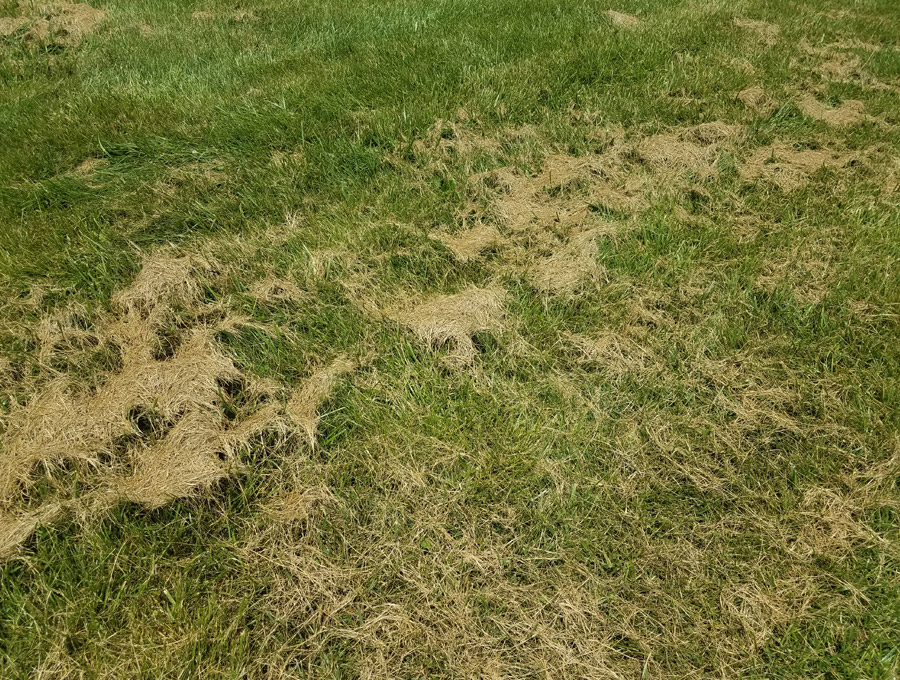3 Steps to Successfully Thatching Your Lawn

It’s a common sight on many lawns: A brown layer of dead grass at the roots of green grass. If you’ve seen this on your lawn, you might wonder what this is and how you can deal with it. It’s called thatch – and it can be a bigger problem than you might realize.
That’s why one of the first steps in your spring clean-up routine should be to thatch your lawn. Thatching helps break up and remove the thick layer of dead grass and organic matter that can stifle healthy lawn growth. It allows nutrients, water and sunlight to get down to the roots, promoting a lush and healthy green lawn.
What is thatch?
Over time, grass clippings, dead leaves and other organic matter can become compressed and compacted, creating a thin layer of dead material – or thatch – that prevents air, water and fertilizer from getting to the roots of your grass. This causes your lawn to grow thinner and die. It often develops when a lawn is overfertilized, requiring frequent cuttings that cause leftover clippings to build up at the soil surface.
How much is too much?
A thin layer of thatch – less than half-an-inch thick – can be beneficial to lawn growth and health. This thin layer helps grass roots absorb and retain water, nutrients and air so it can thrive year-round.
When thatch layers grow too thick – an inch or more – it becomes a barrier to lawn health. This thick layer of dead matter blocks water and fertilizer from reaching grass roots and can suffocate your lawn.
Do I need to thatch my lawn?
Not every lawn needs to be thatched each year. If you have a relatively new lawn, thatching could actually damage your grass.
PRO TIP: If you have a newer lawn, wait three to five years before thatching to prevent damage to the grass.
If your lawn is mature and growing well, without a lot of compacted organic matter at the grass roots, you probably don’t need to thatch. But if you notice your lawn is showing signs of weak or thin growth, check at the roots of your grass. If you see a layer of thatch that’s an inch or more thick, it’s time to thatch.
Tips to ensure successful thatching
- Schedule in spring or fall. It’s important to choose the right time frame to thatch your lawn. In Wisconsin and Illinois, the best time to thatch is during the active growing season in the spring – ideally late April. You can also thatch in the fall at the end of October or early November, or at least four weeks before the first frost.
- Thatch first, then aerate and fertilize. After thatching is complete, it’s a great time to aerate your lawn. An aerator has specialized tines that pull out short plugs of grass and soil, creating narrow holes in your lawn. These plugs break up and soften before being reabsorbed by the soil, resulting in a softer, more penetrable surface within about two to three weeks. Then you can fertilize your lawn to get it back on track for thick, lush, green beauty.
PRO TIP: If you already have a maintenance contract with a landscaper, check to see if thatching and aerating are included in the package. If not, ask for it to be included.
- Hire a pro. Thatching can be tricky – and doing it improperly can damage your grass. Working too gently can remove only a fraction of the thatch. Working too deep can permanently damage your grass. Most tools available to residential homeowners only work above the soil, which leads to inefficient and incomplete thatch removal. Commercial thatchers can effectively grind up the thatch layer without damaging grass roots.
What’s more, thatching can produce significant amounts of organic material that need to be properly disposed. Skip multiple trips to your local yard waste collection site by hiring a pro to handle the entire process for you.
PRO TIP: Most thatching tools available to homeowners will remove only about 50% of the thatch in their yard. Commercial thatchers will remove upwards of 90%.
The bottom line? Even if you’re a DIY lawn expert, it’s worth hiring a pro to thatch your lawn.
Find out if you need thatching as part of your spring cleaning routine. The Reesman Company is the expert in getting your lawn ready for the season. Call 262-539-2124 to speak with one of our landscape professionals or contact us for more information on how to keep your yard beautiful all year long.



